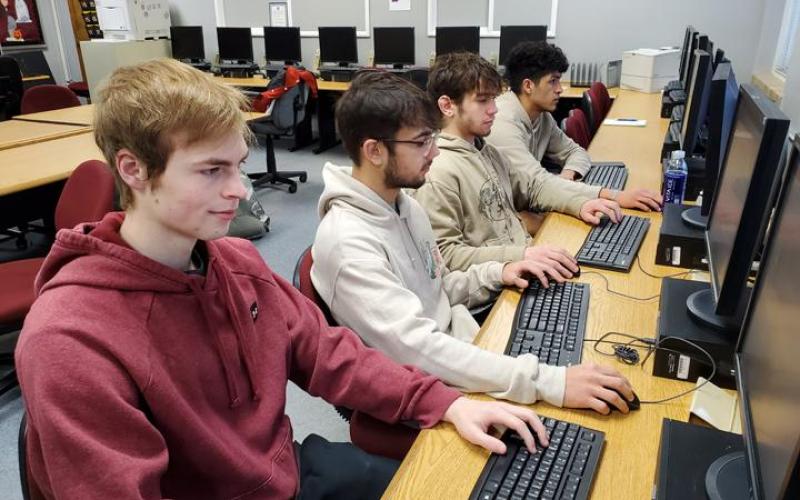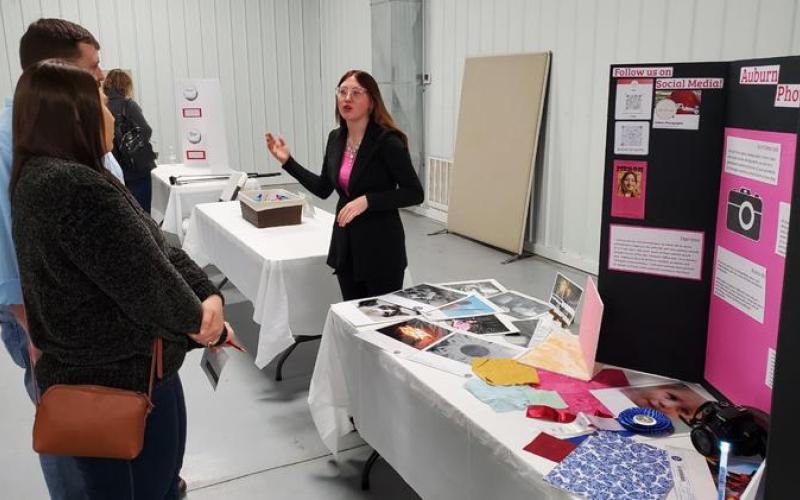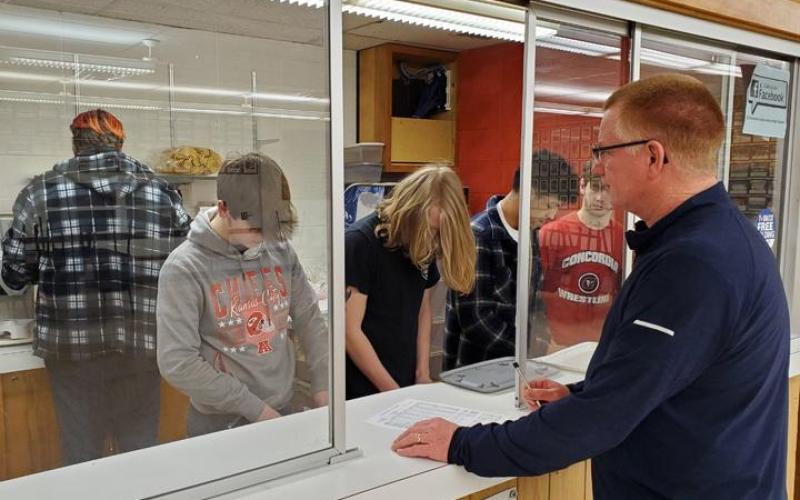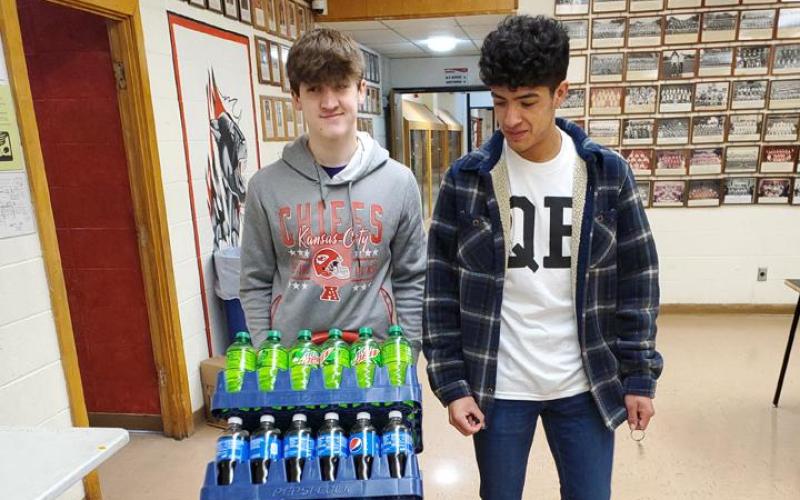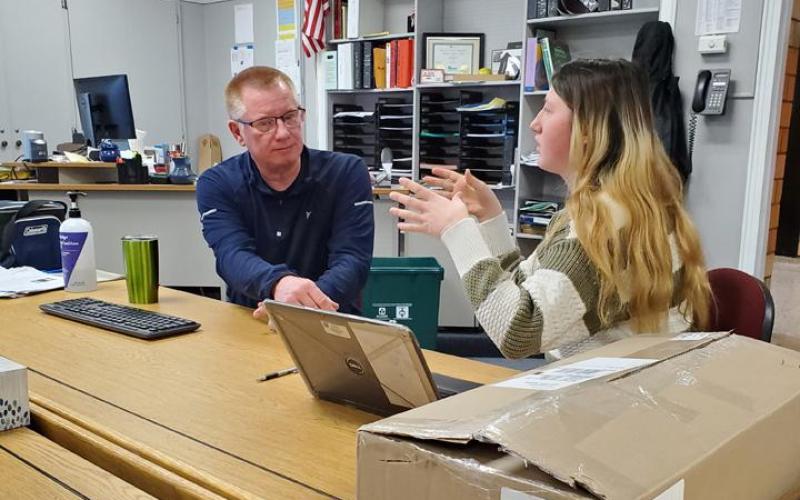CTE - The Evolution of Learning: Business Finance
Career Technical Education (CTE) has evolved over the decades, broadening the learning experience of students on everything from power tools to accounting to life-saving CPR.
At Concordia Jr/Sr High School, CTE learning is divided into Career Clusters, which are further divided into Pathways that include over 50 classes for students. Each Pathway has an Introductory Level of courses that are broadly focused and provide a first-look at many skills and careers within a Cluster; a Technical Level of classes that build skills in focused courses; and an Application Level that provides real-world experiences and training, and allows students to use the skills they’ve developed.
In this article we took a closer look at the Business Finance Pathway. There are 11 classes in this Pathway: Business Economics, Business Communications, Business Law, Entrepreneurship, Advanced Spreadsheet, Applications, Banking & Finance, Investing, Risk Management & Insurance, Advanced Accounting, and College Accounting.
I visited Entrepreneurship 1, a Technical Level class taught by David Gieber. The students are Megan Barr, Joshua Bray, Reece Knox, Brett Rosenbaum, Ryan Senner, Koby Tyler, Daniel Vines, and Alan Garcia.
“The main goal here is for them to learn financial responsibility and a work ethic,” said Gieber, who has been teaching business classes for 31 years. “They know that people are relying on them to get the job done right.”
In Kansas, each Career Cluster has Common Career Technical Core (CCTC) Standards for the students. The goal is to instill in the students core values such as communicating clearly, effectively, and with reason; demonstrating creativity and innovation; using technology to enhance productivity; and being mindful of the environmental, social, and economic impacts of decision making.
Gieber is a big fan of the CTE training. “I think CTE is fantastic for the kids. They now get workplace and real-life experiences that they can use for a lifetime. I like that they're learning and it's not just out of a textbook.”
The day began at 7:50 a.m. I stood in the hallway with Gieber as he visited with other teachers and said hello to students that passed by. The Chiefs' win in the Super Bowl was a popular conversation topic, so the day was off to a good start.
Once in the classroom, the Entrepreneurship 1 students claimed a seat either at a computer terminal or the expansive planning desk. The atmosphere was relaxed. The first thing most of the students did was check their stock portfolios.
At the start of the year every student in the class was given $100,000 of pretend money to invest in the stock market, buying and selling stock as they see fit.
Ryan Senner was happy. His stocks made a profit from last week. Daniel Vines' portfolio was also profitable. His best stock to-date was Hershey. “It was down a lot,” Vines said. “I thought it might come back, and it has.”
The students are all glad that their stocks are doing better than their teacher's. “At the moment, I'm in last place,” Gieber said
So far, the best stock portfolio belonged to Brett Rosenbaum. Did he have any keen insight or investment wisdom to pass along to readers? “Invest in what you know,” he said matter-of-factly.
“He actually does the opposite of a classmate,” Gieber chimed in.
Rosenbaum didn't argue with that. “It's worked well so far.”
I suggested a couple of stocks to Rosenbaum and Vines. They seemed less than enthused. “The way things are now in the world,” I said to them, “how can you go wrong with an oil company?” Apparently, you can go a lot wrong. When I checked the price on Exxon Mobile Corp at the end of the day, it was down $1. Hershey was up forty-one cents.
Each of the students also mapped out a business that they presented at the Cloud County Youth Entrepreneurship Challenge (YEC) that was held on March 6 at the Fairgrounds Building.
The YEC promotes entrepreneurship and small business development in Cloud County and throughout Kansas. The competition is for student created, managed, and owned ventures. “I allow the students to pick whatever business they want,” Gieber said. “I want to see their thoughts and their creativity as they put the plan together.”
At the YEC, each student presented an Executive Summary - a business plan - including details of how the business intends to operate; an Elevator Pitch, which is a short explanation and overview of the business to a panel of judges; a Formal Presentation where each business shares details of its product or service with a panel of judges; and finally the Tradeshow: a 90-minute expo where businesses have the opportunity to pitch their product or service to judges using a display booth as a visual and informational aid.
Reece Knox, who plans on attending Kansas State University to study Mechanical/Electrical Engineering, put together a company called Knox Engineering.
Megan Barr's company reflected her passion: photography. “I call it Auburn Photography,” she said. “I want to be a professional photographer. My business is an indoor space for photography, and it will also have selfie pods, where people can take selfies with their friends.”
Brett Rosenbaum's company is Rural Putt. “It's an indoor mini golf course and bar,” he said. “It'll also have golf simulators for playing when the weather gets cold.”
Josh Bray's company is Odin's Hall of Ravens, a business that focuses on the uber-popular Dungeons and Dragons (D&D) tabletop role-playing game that was started in 1974. “This is a magic gallery and a D&D shop,” he said. “We'll sell cards, books, figurines... it's for new players and veteran players.”
Vines' company is Hot Dog Kingdom. “It's a food truck. I don't have a partner, so mine is a sole proprietorship. A lot of people like hot dogs. But the secret here is,” he added with a grin, “my company incorporates love into every hot dog.”
Ryan Senner incorporated summer fun into his business start-up. “It's a water park called Summer Soak Water Park” Senner said. “It will have everything you can think of for summer water fun.”
There were no limitations on the student-created businesses. Even the cost. Senner's water park would be expensive to build. “This will cost a million dollars, or more,” Senner said. “I know the one in Salina cost a hefty amount.”
Alan Garcia, a senior, had his business all planned out. “It's called Con Kicks – a clothing store,” he said. “I'll sell clothes and shoes at a fair price so people aren't overspending.”
Garcia said the business classes at CHS have been very helpful to him. “I know I want to open my own business in the future, and I'm learning what to do to get started... and what not to do.”
Gieber spent a portion of class time working with the students on their YEC presentations, and then it was off to do hands-on work for a real business: the CHS concession stands.
The business department at the high school is in charge of the concession operations, and manages all aspects of the business. Various clubs at the school, from sports to academics, handle the retail side of the business – selling the product at games. The net profits are then deposited into that club's Student Activity Account to use for club needs.
As an example, when the girls' softball team ran a concession stand for a night, they used the proceeds to purchase hitting tools for the team to improve their batting technique.
“If it's a sports club, most of them use their account funds for some type of equipment,” Gieber said. “An academic club may use their funds for travel expenses to a competition somewhere. For the FBLA (Future Business Leaders of America) club, we'll use some of our funds to pay the entry fees for the state competition.”
There was a junior high basketball game the previous evening, so the first thing the class did was inventory the remaining stock to see how much was used. The inventory accounts for everything: candy, drinks, hot dogs, hot dog buns, cheese for the chips, napkins – even the oil for the popcorn machine.
“The biggest problem is perishables, like the hotdogs,” Rosenbaum said.
This morning six hotdogs were left in the unplugged warmer. They had to be thrown away. Rosenbaum and Vines then had the unpleasant task of cleaning the warmer. After a little fuss with bottles of spray cleaner and soap and water, Vines had to do a little cleaning on Rosenbaum, too. “I got soap on him,” Vines said, not really apologizing. “That was a total accident.”
Bray, Knox, and Garcia counted the bottles of water and pop to see how much was left. That total was then subtracted from the total number of bottles stocked in the refrigerator before the game, and thus determined how many were sold. Each bottle of water sold is 100% profit, because the water is generously donated by Amber Lambertz and Farm Bureau Financial Services.
Senner and Tyler counted the M&Ms and other candies to determine their inventory results, and then moved on to the popcorn machine. “Reed Seed Sales donates the popcorn, and United Bank & Trust donates the popcorn bags,” Senner said. “Oil and salt are the club's only expenses for popcorn.”
Gieber wrote it all down in an accounting ledger. The cost of the goods that were sold the night of the game, and taxes, are then subtracted from the receipts to figure out that club's profits for that night's game.
“A good night with basketball might bring in $700 for the club,” Gieber said. “Varsity football games are the best for concessions.”
The biggest sellers at the concessions stand? Bray checked the accounting sheet. “Water and Pepsi,” he said.
As the accounting part of the work was wrapped up, restocking the concession stand for the next game began. Tyler checked the schedule and saw that the next concession was for varsity and junior varsity basketball games. So the stand was restocked completely full.
“The big issue is judging how busy a night might be, especially the perishable items,” Gieber said. “You don't want to have too much out.”
After inventorying and restocking the concession stand and preparing it for another night of sales, the students were back in the classroom only a few minutes before the bell rang and class was over. It was a busy day.
The modern-day version of CTE is certainly not the technical education I was offered in school. It has evolved into a broad-based learning experience with a hands-on approach and elevated levels of student experience. It was impressive to see CTE in action.
NOTE: Megan Barr's business 'Auburn Photography' finished in second place and won $350 at the Cloud County Youth Entrepreneurship Challenge.
COMMING NEXT FRIDAY: Digital Media Design & Production


